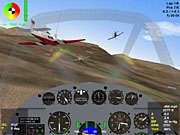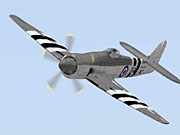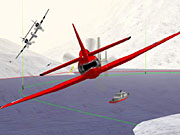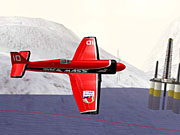Typically, games that use the once-trendy term "extreme" (or its misspelled variant "xtreme") in their titles are memorable only for their distressingly poor quality. But Xtreme Air Racing is the polar opposite of practically every extreme game that came before it. A tribute to the winged hot rods and daredevil pilots that compete every year in Nevada's Reno Air Races, Xtreme Air Racing is one of the most innovative and entertaining flight simulations to take flight since the turn of the new millennium.

Unlike traditional flight sims, which for the most part deal with the complexities of a quasi-realistic physics model, instrument panel, radio communications setup, and take-off and landing routines, Xtreme Air Racing adds a compelling element of danger: high-speed wing-to-wing competition. In this way, the game feels like an airborne adaptation of Papyrus' NASCAR Racing. And this enjoyable game should prove equally appealing to hard-core simulation aficionados, reflex-crazed air combat fans, and yes, even automobile race junkies.
Certainly those who enjoy the nuts and bolts of real aircraft should not take Xtreme Air Racing as lightly as its name might suggest. For starters, the game features virtual representations of many of the most important real-life aircraft and personalities that actually compete every September at Reno. Veteran pilot Skip Holm flies his restored 1944 P51D Mustang, "Dago Red," which is the very same plane that has dominated the unlimited class for the last half-decade. Tom Dwell flies the recently revamped 1953 Hawker Sea Fury "Critical Mass," and Lyle Shelton pilots the multiple championship winner, the 1946 Grumman F8F Bearcat "Rare Bear." Developer Victory Simulations has constructed numerous fictional airplanes to fill out the roster and has even resurrected the F4U Super Corsair of Fighter Rebuilders, which was destroyed at Phoenix in 1994.
Not only can you fly all these vintage, tricked-out aircraft, but you can modify them too. Indeed, if you expect to progress beyond the introductory levels, you must learn how to effectively make some adjustments. The Xtreme Air Racing hangar (essentially a racing-game garage), is a complicated place that lets you exchange a Rolls Royce engine for a Pratt & Whitney R-2800-32W, increase and decrease your propeller diameter or reduction gearing, vary your wing dimensions, and decide on an appropriate fuel and radiator coolant load. You may even want to augment your nitrous oxide supply for that extra boost during longer races.
What you do is entirely up to you, but rest assured that each tweak really does make a difference. Of course, the only way you'll know if you've assembled a faster, more agile, and more capable machine is to take it for a test spin. The game really excels when you're in the air, where you'll find yourself coming to grips with its impressively deep flight model amid real-world conditions such as wake turbulence (produced by your competitors) and visual G-force effects such as redouts and blackouts.

In fact, simply keeping your craft off the ground, within the ceiling restrictions, and tight to the pylons that define the course is a continuing challenge that's sure to keep you fixed on the screen at all times. Victory Simulations has fashioned a machine that echoes most every trait found in the real world, thereby rewarding careful planning and a deft, subtle touch. If you do happen to venture too wide on a given turn, you certainly can't yank and crank your aircraft back into proper position without also experiencing numerous realistic and oftentimes violent reactions. In short, you will most often feel as if you're flying a real airplane.
And then there are your fellow racers, who zip around the courses like a flock of angry bees, bobbing and weaving into better position while doing their best to avoid smacking each other--or you. Although the game's AI crash-avoidance system is extremely good, the possibility of unexpected and unwanted collisions does exist. And if your faulty driving skills don't get you, your own neglect or forgetfulness might. Your engine temperature may rise, in which case you must trigger your spraybar to cool the radiator. You may find yourself lagging behind and therefore compelled to hit the nitrous--but not so much as to overheat again. In Xtreme Air Racing, when you're not busy doing something, you're busy pondering your next move.
With this sort of edge-of-the-seat action, Victory Simulations could have been forgiven for constructing a limited number of venues. Yet the game offers a variety of locations from around the world, from Reno to a Nordic fjord and several points in between. Each site features several course configurations, including small ovals, figure eights, lengthy endurance layouts, and a bonus or two. Like the aircraft, the majority of circuits remain locked until you've proven you can handle the easier events. Three difficulty levels add even more variety, as do an assortment of specific gameplay options and pilot assists. If you don't want to crash, for example, you can simply switch off collisions. If you'd like a better view of the tiny earthbound course boundaries, you may select one or more floating visual aids. And if you happen to grow weary of the concept, the game also features a short but sweet combat mode wherein you'll scoot about in pursuit of your nemesis and in so doing realize just how complex those flight physics really are.

Although Xtreme Air Racing is not the prettiest flying game ever made, it is far from unattractive. The actual aircraft really look the part, shaped just like their real-life counterparts and colored and decaled in full racing trim. Flaps and rudders move just as they should, and landing gear will snap off and disappear in the distance if deployed at high speed. The game offers a terrific number of viewer perspectives, most of which may be zoomed in or out. However, the terrain is quite bland. Although oceans and lakes look sufficiently watery, and landmasses look sufficiently hilly, the quantity and quality of detail is lacking. Apart from scatted buildings and trees, land is depicted as vast swatches of uninteresting texture. Moreover, you won't find any precipitation in these perennially clear skies, nor can you fly at night. Then again, the exceedingly close-knit, stock car-like competition of the real-world Reno race dictates that they never be held during severely inclement weather or after dusk.
In the cockpit, you can use your hat switch to smoothly turn your virtual head in any direction or to look down to monitor the rather rudimentary but fully operational instrument panel. Pilots are quite visible through their translucent windscreens, and the skies are festooned with clouds, hot-air balloons, pretty lens-flare effects, and, of course, a squadron of energetic aircraft. And if you do manage to smack the deck, Xtreme Air Racing will reward you with one of the most impressive crash sequences of any flight sim. Wings and tails will detach, thick black smoke will permeate the surroundings, and charred fuselages will tumble to a stop. At the culmination of particularly harsh impacts, you'll see numerous chunks of wreckage strewn about the countryside, each section burning and smoking and looking eerily like the results of a real-life disaster.

Xtreme Air Racing's audio is both adequate and useful. Although the sound of your own engine isn't especially dynamic, your cabin will reverberate with the whistles and swooshes of the buffeting wind, varying in accordance with your current tack and velocity. Your competitors' motors will become louder as they approach and softer as they withdraw. And if you choose to do so, you'll also have two voices in your head while you're flying. The first is that of veteran real-world circuit announcer Gordon Bowman-Jones, who regales you with current standings and even up-to-the-second gap times. Unfortunately, he delivers his limited lines overenthusiastically and with a sense of humor that tends to grow tedious after repeated exposure. The second is that of accomplished pilot R.A. "Bob" Hoover, who, in contrast, calmly and coolly delivers remarkably situation-pertinent advice and assurances.
Serious flight and race enthusiasts will find much more wisdom by consulting the enclosed 100-page-plus virtual manual, a wonderful piece of work in which the game's many intricacies are fully explained. You can also find additional, more-detailed information on the game's official Web site.
If Xtreme Air Racing has a serious flaw, it's the load time you have to sit through the first time you load up a course. We wound up waiting for a minute or more just for the game to make the transition from its menu interface to the gameplay screen. This delay is trimmed to a substantially more acceptable time frame if you're accessing a course for a second or third time, but that initial holdup may be enough to frustrate even the most patient pilot.
Don't be deceived by the game's title. Xtreme Air Racing is an innovative and exciting cross-genre game that should keep computer-game pilots and racers busy for a good long while.